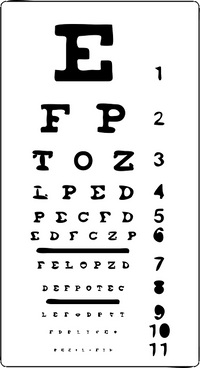Eye Exams & Their Results: What 20-20 Vision Means

Whether you’ve never worn glasses or contact lenses or are getting ready for your next trip to the eye doctor, you might be wondering how visual acuity is measured. What does it actually mean when vision is described as 20-20? As a leading Washington, MO, optical practice, the team at Comprehensive Eye Care, under the direction of Dr. Michael Korenfeld and Dr. Nathan Tuttle, field these types of questions all the time. Since part of their mission is to promote education about optometry and eye health, they’re happy to provide some answers.
So what is 20-20 vision? How do eye exams work? Here, this dedicated optometry team clears some things up:
 Comprehensive Eye Exams: There are multiple components to comprehensive eye exams. In addition to visual acuity, the doctor needs to measure things like the presence of glaucoma and internal ocular pressure. To assess how well you can see things that are far away, the eye doctor employs something called the Snellen Chart. It’s the sort of stereotypical chart you might recognize from TV or movies that has letters that get progressively smaller.
Comprehensive Eye Exams: There are multiple components to comprehensive eye exams. In addition to visual acuity, the doctor needs to measure things like the presence of glaucoma and internal ocular pressure. To assess how well you can see things that are far away, the eye doctor employs something called the Snellen Chart. It’s the sort of stereotypical chart you might recognize from TV or movies that has letters that get progressively smaller.- A Measure Of Acuity: This is measured by comparing what is expected for a person to see and what they actually can make out. The person with 20-20 vision can see with as much accuracy at 20 feet away as a normal person, so this means that acuity is perfect. Vision needs to be corrected when the measure goes beyond 20-40, meaning that something at 20 feet for them is as clear as something more than 40 feet away for a healthy viewer.
- Implications: But what does this all mean in practical terms? Basically, people with 20-40 vision can go without glasses (though they may want them) and can still get driver’s licenses in most states. 20-80 means that a person will be able to make out an alarm clock from 10 feet away, as well as most newspaper headlines. At 20-200, however, you’re looking at a case of legal (but correctable) blindness; you might be able to read a stop sign, but not much else.
If you wear glasses or contacts, are suffering from other ocular ailments, or suspect you might need vision correction, the team at Comprehensive Eye Care is ready to help. To learn more about this full-service optometrist and eye doctor, stop by online, or call (636) 390-3999.
About the Business
Have a question? Ask the experts!
Send your question

